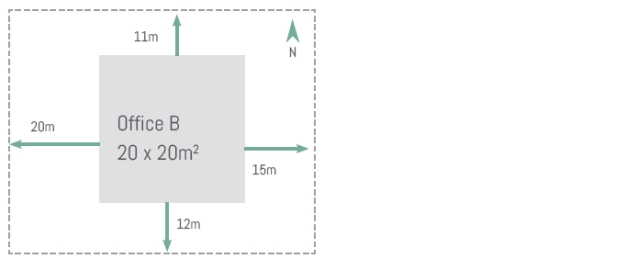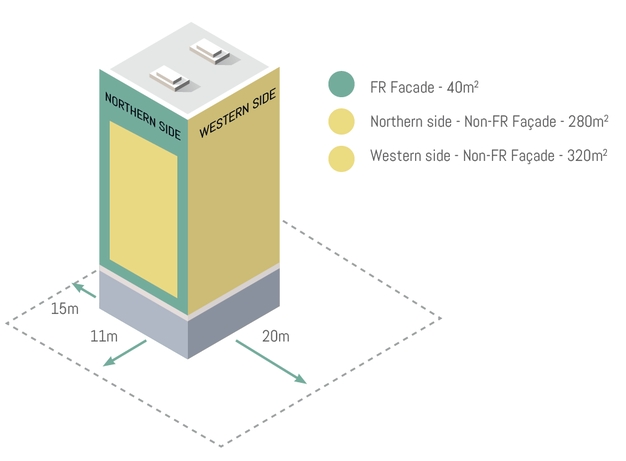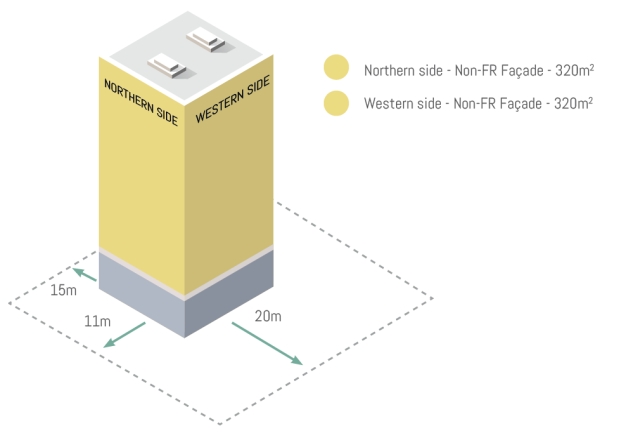Case study B for offices to show where automatic sprinklers have the greatest impact
This article was originally published as part of The impact of automatic sprinklers on building design, an independent report produced by WSP, sponsored by the Business Sprinkler Alliance (BSA), published in September 2017.
See also: Case study A for offices to show where automatic sprinklers have the greatest impact.
This example features a four-storey office building located in Manchester with 1,600m2 GIA and fully-glazed facades. The separation distances around the building are:
- Offices 20x20 m2.
- 4 storeys – c. 16m.
- Separation distances are; Northern side 11m, Eastern side 20m, Southern side 12m, Western side 15m.
- Glazed façade.
- Occupancy capacity of the building.
- 2 staircases.

|

|

|
Firstly, the impacts of incorporating an automatic sprinkler system on the fire protection measures are demonstrated in Table 6-4. Secondly, cost analysis of the impacts is conducted in Table 6-5.
[Table 6-4 Impact of sprinklers on the required fire protection measures for Building B]
| BUILDING B | Without Sprinklers | With Sprinklers |
| Fire-rated façade area required |
Northern side (12.5%) = 40 m2 Southern side (0%) = 0 m2 Eastern side (0%) = 0 m2 Western side (0%) = 0 m2 |
Northern side (0%) = 0 m2 Southern side (0%) = 0 m2 Eastern side (0%) = 0 m2 Western side (0%) = 0 m2 |
| Stairs minimum width | 1000 mm Stairs area 24m2 per floor | 1000 mm Stairs area 24m2 per floor |
| Structural fire protection rating | 60 minutes | 30 minutes |
| Dry risers | 1 | 1 |
[Table 6-5 Cost analysis of incorporating sprinklers in Building B]
BUILDING B
Without Sprinklers
With Sprinklers
£0
£97,600
Façade cost14
Non FR façade= 1,240m2 x £600/m2 = £744,000
60min-FR façade= 40m2 x £1,700/m2 = £68,000
Total = £812,000
Non FR façade= 1,280m2 x £600/m2 = £768,000
Total = £768,000
Structural fire protection cost
60min-FR = 1,600m2 x £21.57/m2
= £34,512
30min-FR = 1,600m2 x £12.38/m2
= £19,808
Rental yields derived from changes to net internal area
0 m2
0 m2
1 x £1,500/landing x 4 floors =
£6,000
1 x £1,500/landing x 4 floors =
£6,000
£852,512
£891,408
Total cost impact of sprinklers
Capital cost impact = £38,896 added to the project cost plan by including sprinklers
Verdict: Installing automatic sprinklers in Building B is shown to add cost to the project and would not be recommended when reviewed against the impacts (cost, aesthetics etc.) reviewed herein. Unless there is another requirement requiring their inclusion (business continuity, property protection).
Reference [14] Glazed fire rated façade assumed required for aesthetic reasons by the client.
[edit] Related articles on Designing Buildings
- Automatic fire sprinkler systems: A good practice guide.
- Automatic sprinkler system design and operation.
- Business Sprinkler Alliance.
- Case study A for offices to show where automatic sprinklers have the greatest impact.
- Costs of water automatic sprinkler systems.
- Design benefits of automatic sprinkler systems granted under approved document B
- Drenchers.
- Fire detection and alarm system.
- Fire detector.
- Fire in buildings.
- Fire protection engineering.
- Fire safety design.
- Overview of automatic sprinkler system design and operation
- Sprinkler systems explained: A guide to sprinkler installation standards and rules.
- Sprinklers.
- The cost efficiency of different combinations of fire protection measures.
- The impact of automatic sprinklers on building design.
- Watermist systems for fire protection in domestic and residential buildings DG 534.
Featured articles and news
Key points for construction at a glance with industry reactions.
Functionality, visibility and sustainability
The simpler approach to specification.
Architects, architecture, buildings, and inspiration in film
The close ties between makers and the movies, with our long list of suggested viewing.
SELECT three-point plan for action issued to MSPs
Call for Scottish regulation, green skills and recognition of electrotechnical industry as part of a manifesto for Scottish Parliamentary elections.
UCEM becomes the University of the Built Environment
Major milestone in its 106-year history, follows recent merger with London School of Architecture (LSE).
Professional practical experience for Architects in training
The long process to transform the nature of education and professional practical experience in the Architecture profession following recent reports.
A people-first approach to retrofit
Moving away from the destructive paradigm of fabric-first.
International Electrician Day, 10 June 2025
Celebrating the role of electrical engineers from André-Marie Amperè, today and for the future.
New guide for clients launched at Houses of Parliament
'There has never been a more important time for clients to step up and ...ask the right questions'
The impact of recycled slate tiles
Innovation across the decades.
EPC changes for existing buildings
Changes and their context as the new RdSAP methodology comes into use from 15 June.
Skills England publishes Sector skills needs assessments
Priority areas relating to the built environment highlighted and described in brief.
BSRIA HVAC Market Watch - May 2025 Edition
Heat Pump Market Outlook: Policy, Performance & Refrigerant Trends for 2025–2028.
Committing to EDI in construction with CIOB
Built Environment professional bodies deepen commitment to EDI with two new signatories: CIAT and CICES.
Government Grenfell progress report at a glance
Line by line recomendation overview, with links to more details.
An engaging and lively review of his professional life.
Sustainable heating for listed buildings
A problem that needs to be approached intelligently.
50th Golden anniversary ECA Edmundson apprentice award
Deadline for entries has been extended to Friday 27 June, so don't miss out!
CIAT at the London Festival of Architecture
Designing for Everyone: Breaking Barriers in Inclusive Architecture.
Mixed reactions to apprenticeship and skills reform 2025
A 'welcome shift' for some and a 'backwards step' for others.



























